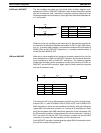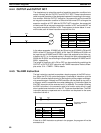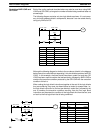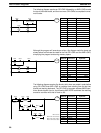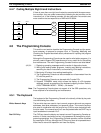
82
Analyzing the above ladder diagram in terms of mnemonic instructions, the
condition for IR 00000 is a LOAD instruction and the condition below it is an OR
instruction between the status of IR 00000 and that of IR 00001. The condition at
IR 00002 is another LOAD instruction and the condition below is an OR NOT
instruction, i.e., an OR between the status of IR 00002 and the inverse of the
status of IR 00003. To arrive at the execution condition for the instruction at the
right, the logical AND of the execution conditions resulting from these two blocks
will have to be taken. AND LOAD does this. The mnemonic code for the ladder
diagram is shown below. The AND LOAD instruction requires no operands of its
own, because it operates on previously determined execution conditions. Here
too, dashes are used to indicate that no operands needs designated or input.
OR LOAD The following diagram requires an OR LOAD instruction between the top logic
block and the bottom logic block. An ON execution condition will be produced for
the instruction at the right either when IR 00000 is ON and IR 00001 is OFF, or
when IR 00002 and IR 00003 are both ON. The operation of the OR LOAD
instruction and its mnemonic code are exactly the same as that for an AND
LOAD instruction, except that the current execution condition is ORed with the
last unused execution condition.
Address Instruction Operands
00000 LD 00000
00001 AND NOT 00001
00002 LD 00002
00003 AND 00003
00004 OR LD ---
00005 Instruction
Instruction
00000 00001
00002 00003
Naturally, some diagrams will require both AND LOAD and OR LOAD instruc-
tions.
To code diagrams with logic block instructions in series, the diagram must be
divided into logic blocks. Each block is coded using a LOAD instruction to code
the first condition, and then AND LOAD or OR LOAD is used to logically combine
the blocks. With both AND LOAD and OR LOAD there are two ways to achieve
this. One is to code the logic block instruction after the first two blocks and then
after each additional block. The other is to code all of the blocks to be combined,
starting each block with LOAD or LOAD NOT, and then to code the logic block
instructions which combine them. In this case, the instructions for the last pair of
blocks should be combined first, and then each preceding block should be com-
bined, working progressively back to the first block. Although either of these
methods will produce exactly the same result, the second method, that of coding
all logic block instructions together, can be used only if eight or fewer blocks are
being combined, i.e., if seven or fewer logic block instructions are required.
Logic Block Instructions in
Series
Basic Ladder Diagrams Section 4-4







